Fahlman B.D. Materials Chemistry
Подождите немного. Документ загружается.

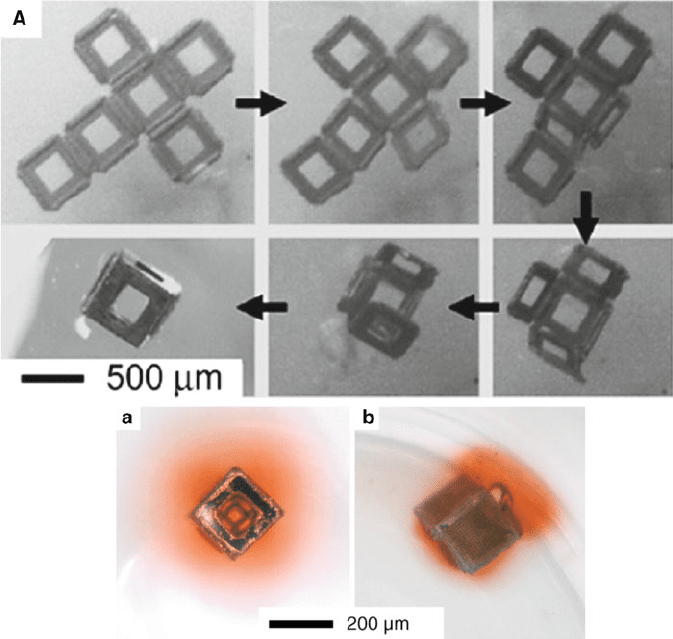
increasing number of applications such as: antistatic electromagnetic shielding,
conducting fibers, electrochemical batteries, electrochromic “smart” windows, light-
emitting electrochemical cells, organic field-effect transistors, organic light-emitting
diodes (OLEDs), photovoltaic devices,
[95]
nonlinear optics, and many more.
[96]
Whereas traditi onal polymers feature a satu rated sp
3
-carbon framework, conduc-
tive polymers feature an unsaturated carbon backbone with 1 e
/C atom placed in
sp
2
p
z
(p) orbitals. As we know from resonance structures, the overlap of p-orbitals
on successive C atoms leads to electron delocalization along the length of the
polymeric framework. Though one may surmise that such an inter-connected 1-D
Figure 5.56. Top: video snapshots showing the self-assembly of a lithographically fabricated template
into a 3D hollow container. Reproduced with permission from Adv. Drug Deliv. Rev. 2007, 59, 1547.
Copyright 2007 Elsevier Science. Bottom: optical images of chemical release from containers:
(a) isotropic release of a dye from a container with identical porosity on all faces; (b) anisotropic
release of a dye from a container with varied porosity (five faces with an array of 5 mm pores; the sixth
face has a 160 mm window). Reproduced with permission from J. Am. Chem. Soc. 2006, 128, 11336.
Copyright 2006 American Chemical Society.
418 5 Polymeric Materials
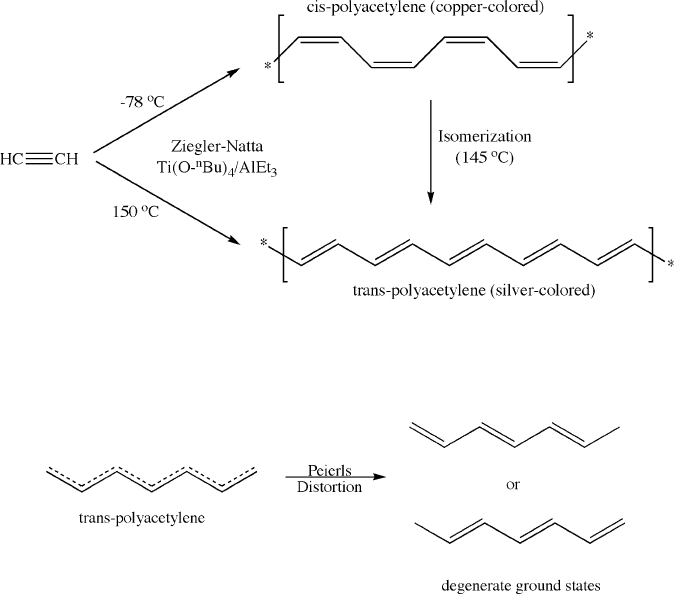
array with delocalized electrons would result in metallic conductivity, this is not the
case. In the 1930s, Peierls
[97]
asserted that a 1-D chain of equally-spaced ions is
energetically unstable, and will distort via an electron–phonon coupling mechanism
to lower its overall energy.
[98]
One may consider the Peierls distortion for chain
structures as analogous to the Jahn-Teller effect for transition metal complexes.
A prototypical example of Peierls distortion is the bond alteration exhibited by
polyacetylene (PA) first synthesized by Natta and coworkers in 1958 (Figure 5.57).
Rather than considering polyacetylene as having equivalent C22C bond distances,
adjacent bond lengths differ by ca. 6 pm (Figure 5.58). This conformational distor-
tion is enough to increase its bandgap, making PA a semiconductor in its pristine
(undoped) state; other pristine conductive polymers such as polyaniline are insula-
tors (Figure 5.59).
In order to incr ease the conductivity, a dopant may be added to the polymer that
will either remove or add electrons (Table 5.6). The influence of doping on resultant
conductivity is striking; whereas the conductivity of pristine PA is ca. 110
7
S
cm
1
, doping may yield values as high as 110
5
Scm
1
– an improvement of 12
Figure 5.57. Synthetic routes for cis- and trans-polyacetylene. It should be noted that the trans-isomer of
PA is more stable than the cis-isomer since the former has two degenerate ground states (two
energetically-equivalent arrangements of alternating double bonds).
Figure 5.58. Illustration of differing C—C bond lengths for polyacetylene.
5.3. “Soft Materials” Applications: Structure vs. Properties 419
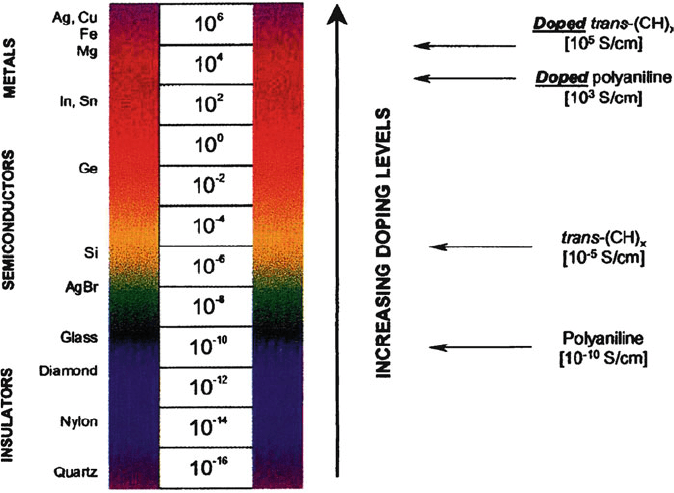
orders of magnitude! However, before discussing polymer doping in more detail, we
should first point out the difference in nomenclature used by solid-state physicists
and chemists. Whereas physicists refer to the generated carriers as polarons, bipo-
larons, and solitons, chemists are more familiar with the terms radical cations/
anions, carbodications/carbodianions, and radicals/carbocations/carbanions, respec-
tively (Figure 5.60).
Redox doping is the first method used to enhance the conductivity of a conjugated
polymer. Oxidative doping (p-doping) occurs when an oxidizing agent such as I
2
,
Br
2
, ClO
4
, AsF
5
, FeCl
3
, NOPF
6
, etc. is added to the polymer, resulting in an
abstraction of an electron and formation of a radical cation, also known as a positive
polaron (Eq. 7). In contrast, reductive doping (n-doping) occurs when a reducing
agent such as alkali metals, LiBu, or Li(C
10
H
8
) is added to yield a radical anion, also
known as a negative polaron (Eq. 8).
[CH]
n
þ3x 2
=
I
2
! [CH
n
xþ
þxI
3
ð7Þ
[CH]
n
þxNa ! [CH
n
x
þxNa
þ
ð8Þ
It should be noted that in contrast to classical band theory, the doped electrons/
holes generated in conductive polymers are not fully delocalized. The reason for
Figure 5.59. Conductivity values for pristine (undoped) and doped conductive polymers, relative to
common metals, semiconductors and insulators. Reproduced from MacDiarmid, A. G. Synthetic Metals:
A Novel Role for Organic Polymers, Nobel Lecture, Dec. 8, 2000.
420 5 Polymeric Materials
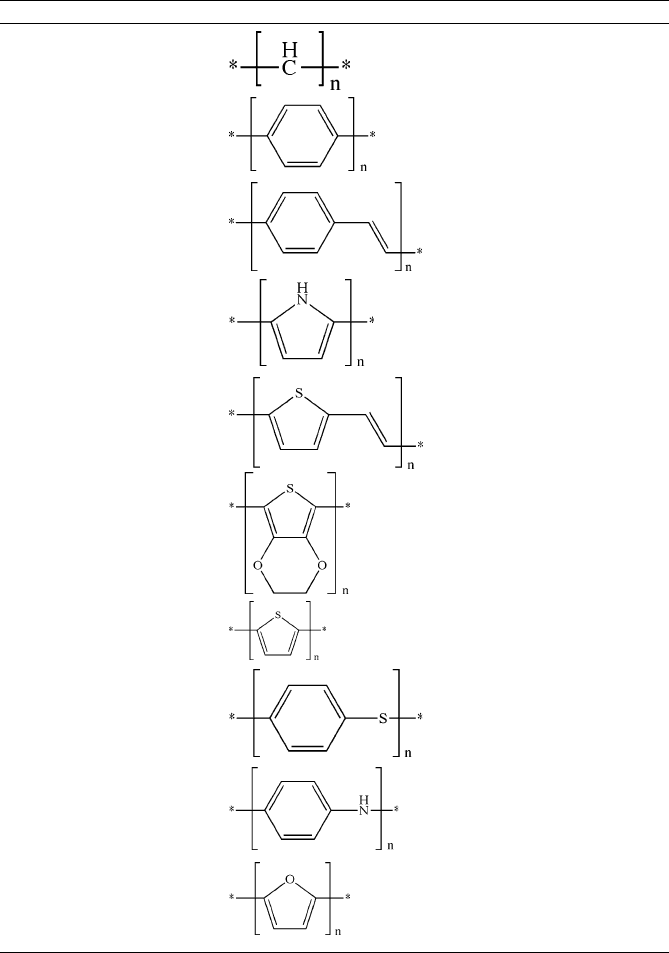
Table 5.6. Common Conductive Polymers
Polymer Structure Dopants O
1
cm
1a
Polyacetylene I
2
,Br
2
, Li, Na,
AsF
5
20,000–150,000
b
Polyphenylene AsF
5
, Li, Na 10,000
Polyparaphenylene vinylene
AsF
5
10,000
Polypyrrole
BF
4
, ClO
4
7,500
Polythienylvinylene
AsF
5
2,700
Polyethylenedioxy thiophene
(PEDOT)
BF
4
, ClO
4
550
c
Polythiophene BF
4
, ClO
4
500
Polyphenylene sulfide
AsF
5
500
Polyaniline (PANI)
HCl 200
Polyfuran
BF
4
, ClO
4
100
(Continued)
5.3. “Soft Materials” Applications: Structure vs. Properties 421
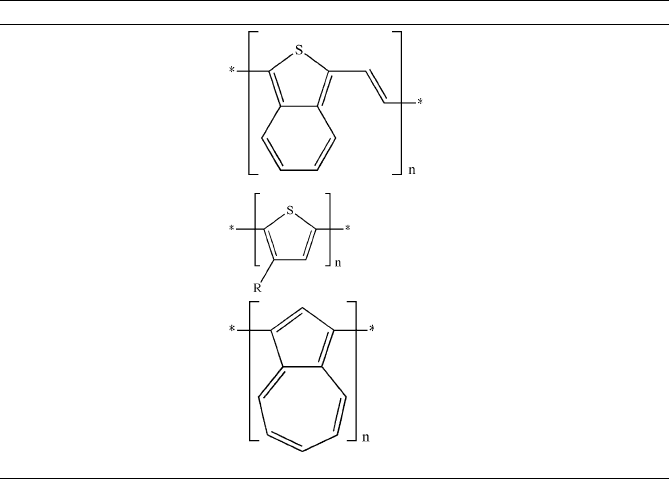
the localization of polarons is due to Coulombic attractions to their counter ions
(e.g., I
3
), which normally have very low mobilities. However, in order to achieve
high electrical conductivities, the polarons must be able to migrate along the
polymer chain. Figure 5.61 illustrates the migration mechanism of a polaron; in
order to migrate, a high conce ntration of the counter ions must be present to induce
the movement of the polaron into the Coulombic field of nearby ions. Accordingly,
high doping levels are required to achieve sufficient conductivity in conductive
polymers. This may be compared with inorganic-based semiconductors such as Si,
which require minute concentrations of dopants due to the pronounced mobility of
electrons/holes through the extended solid-state lattice.
If a second electron is abstracted from a section of the polymer that is already
oxidized, either a second independent polaron may be generated, or two polarons
may condense to form a bipolaron.
[99]
The two positive/negative charges of the
bipolaron are not independent, but rather move as a pair similar to the Cooper pair of
Table 5.6 (Continued)
Polymer Structure Dopants O
1
cm
1a
Polyisothianaphthene BF
4
, ClO
4
100
Poly(3-alkylthiophene)
BF
4
, ClO
4
100
Polyazulene
BF
4
, ClO
4
2.5
a
Maximum conductivity of doped polymers; the conductivity of pristine (undoped) polymers is ca.
0.001–0.1 O
1
cm
1
. The unit O
1
cm
1
is equivalent to S cm
1
.
b
The maximum anisotropic (stretch oriented) conductivity for polyacetylene: Naarmann, H.; Theophilou,
N. Synth. Met. 1987, 22,1.
c
Maximum conductivity of PEDOT is obtained by doping with poly(styrene sulfonate) – PSS. Accord-
ingly, PEDOT:PSS is the industry leader in transparent conductive polymer films, with ca. 80% light
transmission.
422 5 Polymeric Materials
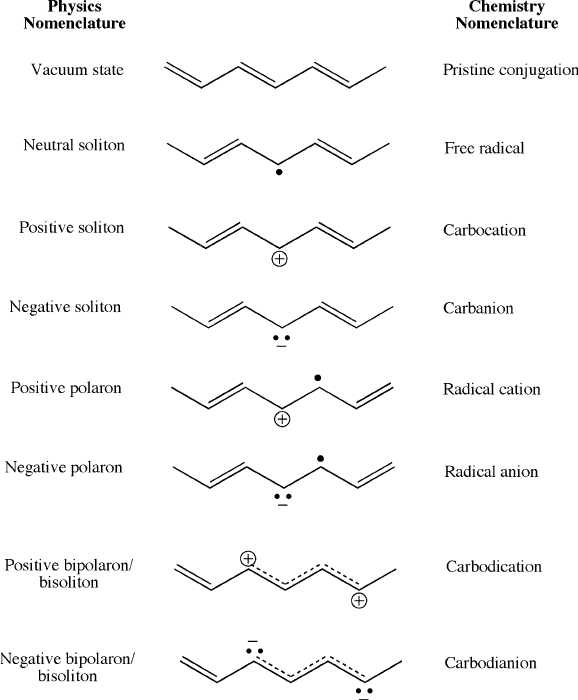
superconductors. In order to broaden the discussion beyond polyacetylene,
Figure 5.62 shows both polaron and bipolaron formation for polypyrrole.
Another type of carrier is known as a soliton, formed by two primary modes:
doping or bond-alternation defect formation (e.g., thermal isomerization of cis-po-
lyacetylene, Figure 5.63a). Not surprisingly, solitons generated via doping are more
prevalent than those formed by thermal isomerization. As illustrated in Figure 5.63a,
solitons may migrate along individual polymer chains by pairing with an adjacent
electron; however, they may also contribute to charge transfer between different
chains via intersoliton hopping (Figure 5.63b ). This latter mechanism is important
for bulk conductivity, since carriers must move readily among various chains in
order to facilitate macroscopic electrical conductivity of the polymer. As the number
Figure 5.60. Nomenclature of the generated carriers within conductive polymers.
5.3. “Soft Materials” Applications: Structure vs. Properties 423
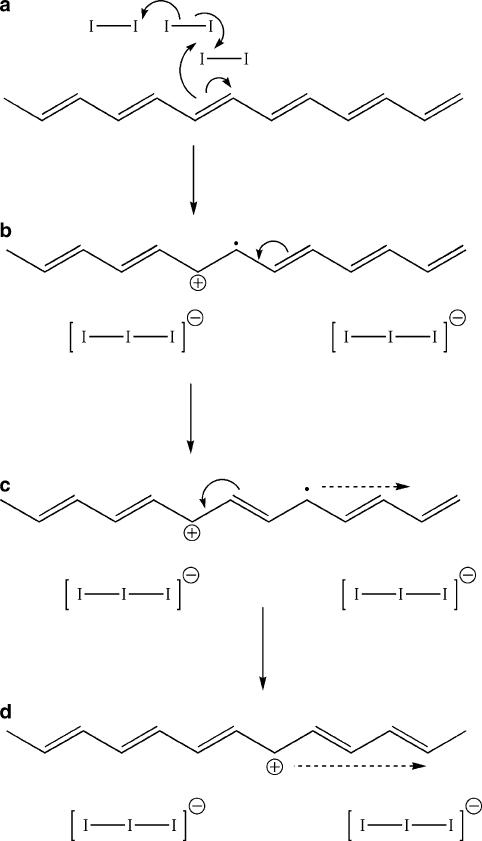
of solitons increases, their spheres of influence overlap leading to metallic-like
conductivity.
Before closing this topic, let’s consider the band structure and optical properties
of doped conductive polymers, once again considering the most widely studied
structure, polyacetylene. If all C—C bond distances were equivalent, one would
expect a partially-filled p-band and metallic conductivity (Figure 5.64a). However,
Figure 5.61. The formation and migration mechanisms of a polaron.
424 5 Polymeric Materials
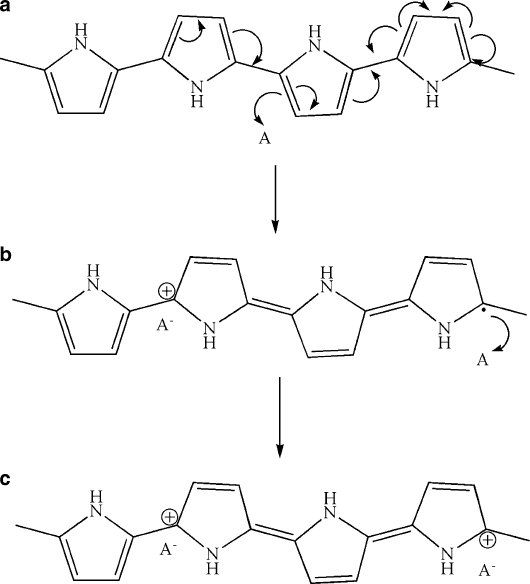
due to Peierls distortion, the p-band splits in half, and a bandgap is now introduced
at the Fermi level (Figure 5.64b). The introduction of polarons and solitons via
doping (or thermal isomerization for soliton formation) generates mid-gap states
(Figure 5.64c, d) whose optical absorption intensity grows at the expense of the E
g
transition (Figure 5.65).
The tremendous benefit of conjugated polymer s is the ability to fine-tune the
bandgap via modification of the polymer structure. This may be achieved via
sterics or electronic effects, by varying either the main chain or its pendant
functional groups . Figure 5.66 lists some of the major applications for conjugated
polymers, from battery to LED applications. Not unlike inorganic-based LEDs,
conjugated polymers may also be designed to exhibit a full range of colors,
from PPV (E
g
¼ 2.5 eV, yellow) to MeH-PPV (E
g
¼ 2.1 eV, red) to polyphenylene
(E
g
¼ 2.7 eV, blue). A polyacetylene battery has also been reported, which employs a
silver anode and I
2
-doped PA as the cathode.
[100]
Conjugated polymers may also be
exploited for the design of wearable electronic systems that incorporate sensing,
monitoring, and information processing capabilities (Figure 5.67).
[101]
Figure 5.62. Polaron and bipolaron formation for polypyrrole.
5.3. “Soft Materials” Applications: Structure vs. Properties 425
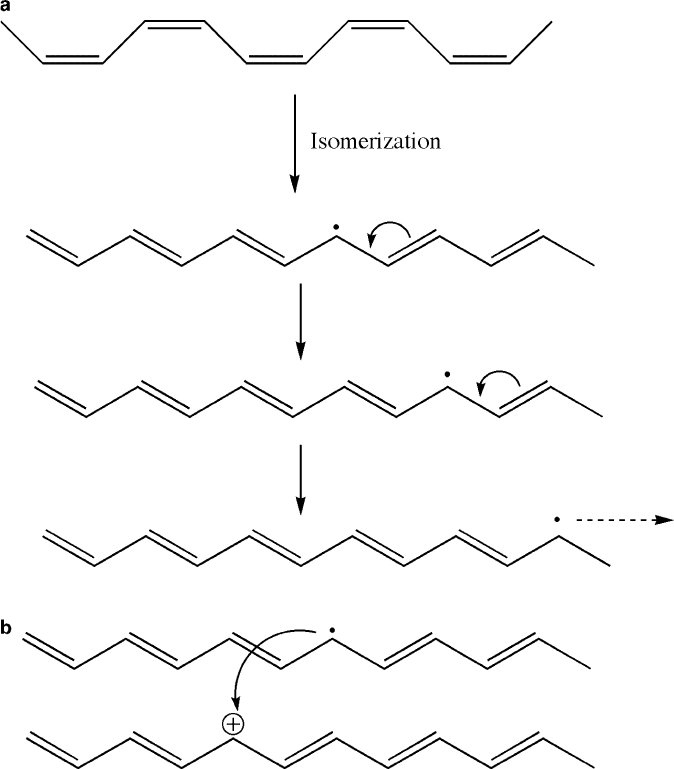
5.3.3. Molecular Magnets
Magnetic materials may date back as far as 2,000 B.C., with the first magnetic
mineral, mag netite, discovered in ca. 500 B.C.
[102]
Present-day magnetic materials
are typically alloys containing iron, cobalt, or other lanthanide metals. In Chapter 3,
Figure 5.63. (a) Soliton formation via isomerization of cis-polyacetylene, and migration along the
polymer chain by pairing to an adjacent electron. (b) Illustration of intersoliton hopping. Charged
solitons (bottom chain) are trapped by dopant counter ions, while neutral solitons (top chain) are free to
move. A neutral soliton on a chain close to one with a charged soliton may interact, with the hopping of an
electron from one defect site to another.
426 5 Polymeric Materials
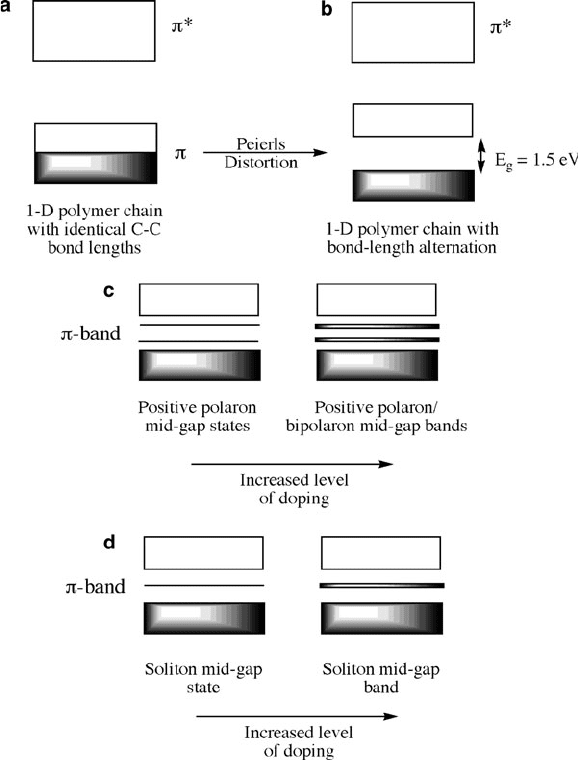
we discussed a variety of magnetic materials and phenomena, which were focused
on inorganic alloys and clusters. Since organic compounds are generally diamag-
netic (all electrons paired), organic-containing molecules have long been over-
looked as candidates for magnetic materials. However, the world of magnetic
materials was forever changed in 1967 when the first organic-based molecular
Figure 5.64. Simplified band diagrams for a conductive polymer. Shown are: (a) polyacetylene if all
C—C bond distances were equivalent (metallic), (b) actual band diagram for PA, resulting from Peierls
distortion, (c) polaron mid-gap states and bands formed upon doping, and (d) soliton mid-gap state and
band formed upon doping. For (c) and (d), note that at higher levels of doping, the mid-gap bands grow at
the expense of the valence and conduction bands, as midgap states are taken from band edges.
5.3. “Soft Materials” Applications: Structure vs. Properties 427
